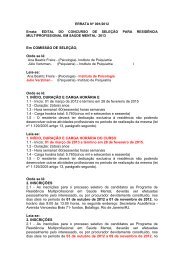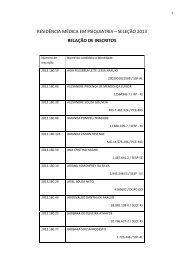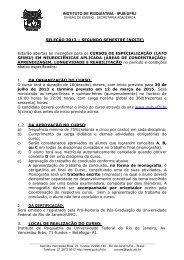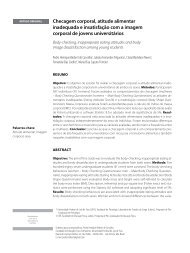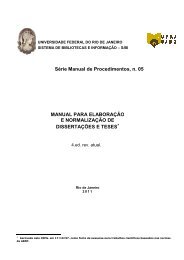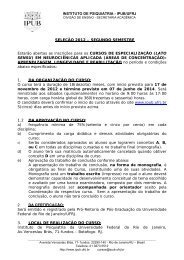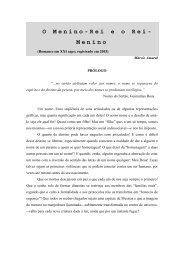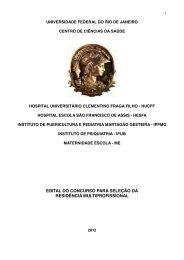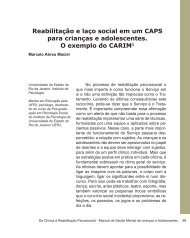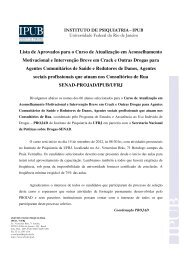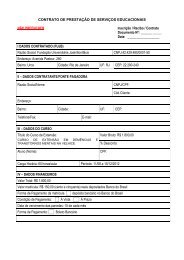Originais â Originals outubro | dezembro ⢠2011 - IPUB - UFRJ
Originais â Originals outubro | dezembro ⢠2011 - IPUB - UFRJ
Originais â Originals outubro | dezembro ⢠2011 - IPUB - UFRJ
You also want an ePaper? Increase the reach of your titles
YUMPU automatically turns print PDFs into web optimized ePapers that Google loves.
ORIGINAL ARTICLE<br />
Panic and cardio-respiratory symptoms<br />
305<br />
Table 1. Socio-demographic and clinical descriptions of the<br />
general population<br />
n<br />
% or<br />
Mean (Standard<br />
Deviation)<br />
Age 50 39,08 (± 12,46)<br />
Minimum = 22;<br />
Maximum = 67<br />
Sex<br />
Male 39 78%<br />
Female 11 22%<br />
Marital status<br />
Single 18 36%<br />
Married 21 42%<br />
Separated 11 11%<br />
Religion<br />
Roman catholic 31 62%<br />
Evangelical 11 22%<br />
Other 8 16%<br />
Schooling<br />
First grade 14 28%<br />
Second grade 19 38%<br />
Higher education 17 34%<br />
Years of study 50 11,82 (± 3,39)<br />
Minimum = 6;<br />
Maximum = 20<br />
Occupational situation<br />
Working 27 54%<br />
Away from work/on leave from work 10 20%<br />
Other 13 26%<br />
Subtype of PD<br />
Non-respiratory 14 28%<br />
Respiratory 36 72%<br />
Clinical comorbidity<br />
No 21 42%<br />
Yes 29 58%<br />
Psychiatric comorbidity<br />
No 26 52%<br />
Yes 24 48%<br />
The combination of CBT with pharmacotherapy was<br />
efficacious for Group 1, compared to the control group 2.<br />
The results of these tests were classified, according to sociodemographic<br />
data, presence of patients with physical and<br />
psychic comorbidity, and administration of medication.<br />
The test results of group 1 are summarized in table 2. Of<br />
the tests applied, 6 (67%) showed positive results in group<br />
1. In the scale of panic and agoraphobia, anticipated anxiety<br />
symptoms were satisfactorily reduced from 2.9 to 2.1;<br />
PAs were reduced from 1.4 to 0.7; agoraphobic avoidance<br />
was reduced from 2.4 to 1.6. In scale of Global Assessment<br />
of Functioning (GAF) 1 , which was scored from 0 to 100 and<br />
considered psychological, social, and occupational function<br />
in a hypothetical continuum, group 1 obtained a significant<br />
statistical increase in global well-being from 60.8 to 72.5.<br />
Patients in group 1 showed a reduced loss of control from<br />
2.8 to 2.1, and reduced fears of physical problems from 2.6 to 2.0,<br />
as evaluated by the agoraphobic cognitions questionnaire 17 .<br />
Patients in group 1 also showed reduction in general anxiety<br />
from 34.9 to 20.0, as evaluated by the Beck Anxiety Inventory 14 ;<br />
and reductions in individual work disability from 5.2 to 0.4; in social<br />
life disability from 4.8 to 2.2, and in family life disability from<br />
4.6 to 1.8, as evaluated by the Sheehan Disability Scale 15 . Overall,<br />
personal disability in Group 1 was reduced from 14.6 to 4.4.<br />
Symptoms in group 1 resulting from PD (including tachycardia,<br />
breathlessness, dizziness, tingling, nausea, perspiration,<br />
and disorientation, among others), was verified through<br />
the application of the Body Sensation questionnaire 17 . The<br />
results showed a general reduction from 3.1 to 2.4.<br />
PA in group 1 was reduced from 1.4 to 0.7, in avoidance<br />
agoraphobia was reduced from 2.4 to 1.6, and anticipated<br />
anxiety was reduced from 2.9 to 2.1, as evaluated by the<br />
panic and agoraphobia scale 18 . Overall, group 1 reduced the<br />
main behaviours verified in PD from 27.9 to 18.6.<br />
Group 2 did not show significant statistical differences<br />
between the beginning and the end of the treatment. The<br />
results of the Sheehan scale showed that the only revea ling<br />
factor leading to comprehension of the difference in the<br />
Sheehan total and Sheehan work value scales is the strong<br />
independent association of the Sheehan work value scale<br />
with psychiatric comorbidity, when controlled for by the<br />
other variables.<br />
It is worth noting that group 2 (the control group) has<br />
more individuals with psychiatric comorbidities than group 1.<br />
This may explain the distinct difference between the Sheehan<br />
total and Sheehan work results.<br />
The psychiatric comorbidity of depression is responsible<br />
for depressive symptoms that can interfere in the professional<br />
work and social life of the individual.<br />
The Sheehan scale showed significant variation in relation<br />
to family when the final averages of group 1 and group<br />
2 were compared. However, this variation is no longer relevant<br />
when the results are controlled against the other variables.<br />
If there are real differences between group 1 and group<br />
2, they may be due simply to pharmacotherapy, with or without<br />
CBT.<br />
The group receiving medication alone had fortnightly<br />
contact with the psychiatrist as well as with the psychologist<br />
for progress of treatment monitoring. We truly believe that<br />
this group was at a disadvantage compared to the group<br />
that received 10 sessions of CBT, borne out in final results of<br />
the study, from the benefits achieved in a number of aspects<br />
with exposure to CBT, such as reduction of panic attacks, reduction<br />
in hyperventilation and cardio-respiratory symptoms<br />
and learning about the restructuring of negative thoughts,<br />
among others. The study was relevant in demonstrating the<br />
important role of CBT in the treatment of panic disorder.<br />
J Bras Psiquiatr. <strong>2011</strong>;60(4):301-8.




